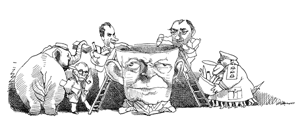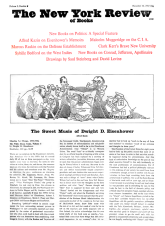This short book contains the text of the Godkin Lectures for 1963 which were given at Harvard by the President of the University of California, an institution which, according to the dust jacket, had “more than 58,000 students on seven campuses.” President Kerr’s subject is the operation and support of such protean institutions whose social functions, various though they are, barely include and surely do not emphasize, the traditional purposes of a university: that is, liberal study, the cultivation of a social responsible intellectual elite, and a sense of continuity with the culture of the past.
The acquisition and organization of knowledge through research are more recent and certainly more conspicuous functions, and the most interesting part of President Kerr’s book is devoted to explaining just how their function changed, as individual scholarship, self-generated within the faculties, has been swamped by federally supported projects. Federal funds may now account for more than four-fifths of a university’s total expenditure; the classic definition of a college as Mark Hopkins on one end of a log and a student on the other no longer quite fits—unless these same gentlemen are pictured as rolling the log instead of sitting on it.
Dr. Kerr is sensitive to these changes, and he is articulate about them. But he does not deplore them. Social psychology has by now established that executives tend to be happier in their work than other men, but even among them, President Kerr is distinguished by his exceptional felicity. The Uses of the University is the work of a deeply satisfied man. So many first-rate creative minds are dismayed by the conditions of modern life, that it is a rare pleasure to observe one of them basking in the light of continued social progress. Dr. Kerr rather resembles Dr. Pangloss with the difference that he is attuned, not to the best of all possible worlds, but to the world as it is. Thus, his reply to David Riesman’s complaint that leading American universities have become “directionless…as far as major innovations are concerned,” is:
The fact is they are not directionless; they have been moving in clear directions and with considerable speed…But these directions have not been set as much by the university’s visions of its destiny as by the external environment, including the federal government, the foundations, the surrounding and sometimes engulfing industry.
This passage appears toward the end of the book where, I might add, his tone becomes somewhat regretful. But his regret is unconvincing, because it contradicts the Social Darwinist position which Dr. Kerr maintains with such complacence throughout this book:
The really new problems of today and tomorrow may lend themselves less to solutions by external authority; they may be inherently problems for internal resolution. The university may now again need to find out whether it has a brain as well as a body.
If, like Father William, the university could be perfectly sure it had none, it could continue to stand on its head, again and again, in response to the social pressures upon it. This, Dr. Kerr suggests, is in effect what it always has done; its traditional activities were merely responses—now obsolescent—to earlier social pressures and opportunities. He traces these changes in the university through Newman, Flexner, Hutchins, and others, whose ideas of what a university should be reflect, like Kerr’s own, the social necessities of their time. These men became commanding figures in the history of higher education because, at the time, command was needed: but today, skilled and flexible negotiators are more useful in expressing “The Idea of a Multiversity” (as the initial lecture in the series is called). Margaret Fuller’s record has been broken: Dr. Kerr accepts the multiverse. And Carlyle’s famous reply still holds—in his position, he’d better.
Dr. Kerr attaches considerable importance to the University’s increasing dependence, since World War II, on Federal support—which he feels results not only in the diversion of scholarship and research into areas which will attract government support, but also a shift in the making of policy, away from the University administration and self-governing faculty groups. President Kerr is, of course, too sophisticated to fear that the government will try to dominate university policy directly—this would seldom serve their interests anyway, and it is a rare form of intrusion. What does concern him is that the coordination of the faculty will be destroyed by the efforts of its individual members to compete for government grants, that professors will seize the opportunity to build empires of their own. He fears that the university will be unable to control them, and that promotion and planning and the allocation of the university’s funds will be subverted by the arrangements with government agencies that favorably situated instructors will be able to make on their own. Dr. Kerr notes that this catch-as-catch-can situation has some desirable features—it can, for example, help to provide recognition to the kind of brilliant work that is often obscured because of antagonism within the university.
Advertisement
But Kerr’s very conception of the multiversity as a structure designed to accommodate itself to social pressures and opportunities only increases his fear that it will disintegrate if exposed to the temptation of government support. Its members are committed to no common undertaking and the center will not hold. The President of the University of California, as eclectic an aggregation of Institutes as ever flourished under a university charter, certainly has reason to think that these risks are real. Dr. Kerr speaks from too much experience to exaggerate the dangers. But these dangers are implicit in his own definition of the university as a complex invertebrate, having an evolutionary history, a nervous system, an elaborate apparatus for ingestion—and no backbone. If the organism itself has no unifying conception to govern it, it has no way control the actions of its members, whether or not, as Dr. Kerr recommends, it may try to do so by altering the bureaucratic balance toward more “institutional grants.” and fewer individual projects.
Nor can it chart its own future—and Dr. Kerr’s concluding lecture, on “The Future of the City of Intellect.” is particularly unconvincing. A City of Intellect would have very little use for a multiversity, and the uses Dr. Kerr conceives of seem to me servile in their readiness to accomodate to immediate social demand:
The real question, it seems to me, is not one of balance in any historical or monetary sense, but rather what is most appropriate to each field in each period…Each should receive support in accordance with its current potentialities, and potentialities vary. There are no timeless priorities….
The major test of the modern American university is how widely and how quickly it adjusts to the important new possibilities. The great universities of the future will be those which have adjusted rapidly and effectively…Knowledge is exploding along with population. There is also an explosion in the need for certain skills. The university is responding to all these explosions….
The vastly increased need for engineers, scientists, and doctors will draw great resources to these areas of the university. Also, some new professions are being born. Others are becoming more formally professional, for example, business administration and social work. The university becomes the chief port of entry for these professions. In fact, a profession gains its identity by making the university a port of entry…. The life of the universities for a thousand years has been tied into the recognized professions in the surrounding society, and the universities will continue to respond as new professions arise.
Of course it is true that the university, like every social institution, is always influenced by the economic needs and structure of the society. But it does not always respond to social influence by simply training up students to the skills and values the society demands. Whatever its contribution to vocational education, the university should be the society’s specialized organ of critical self-scrutiny. It is only when the university functions primarily as a port of entry for aspirants to the higher reaches of the social system that it loses its critical function; for aspirants do not criticize, they accomodate.
I am not saying that true universities and colleges are wholly impossible in this country. But if we accept Kerr’s view of the multiversity’s role, it hardly matters which channels society uses to make its pressure felt: the federal bureaucracies are at least responsible public institutions which set reasonably high technical standards for the work they support. Dr. Kerr establishes convincingly enough that “The Realities of the Federal Grant University,” (as he calls his second lecture), include a substantial loss of autonomy to the granting agencies. But does this matter? He makes it clear that the university would have used that autonomy only to mediate among the conflicting demands upon it. In his concern for the “realities” he sounds like a vice-president for production considering how the new demands of the personnel office will affect output. He does not sound like the head of the largest university in the world discussing the ends of education.
The university has become a prime instrument of national purpose. This is new. This is the essence of the transformation now engulfing our universities. Basic to this transformation is the growth of the “knowledge industry,” which is coming to permeate government and business and to draw into it more and more people raised to higher and higher levels of skill. The production, distribution, and consumption of “knowledge” in all its forms is said to account for 29 per cent of the gross national product, according to Fritz Machlup’s calculations; and “knowledge production” is growing at about twice the rate of the rest of the economy. Knowledge has certainly never in history been so central to the conduct of an entire society. What the railroads did for the second half of the 19th century and the automobile for the first half of this century, the knowledge industry may do for the second half of this century: that is, to serve as the focal point for national growth. And the university is at the center of the knowledge process.
And California, surely, is the ideal case in point. The railroads gave it Stanford, which is a positive item on the balance sheet. The automobile has transformed it, physically and culturally, President Kerr, at ease among the freeways, has convinced me that the multiversity, in its turn, is indeed likely to wreak a comparable transformation in our intellectual life. The City of Intellect, as he conceives it, does finally emerge from the mists surrounding its Future, visible and oddly familiar. Its features are not those of Berkeley, nor even quite of Westwood. This, as we approach it more closely, can only be downtown Los Angeles.
Advertisement
This Issue
November 14, 1963




